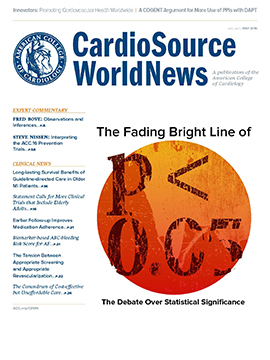Business Consult: Cardiology And Quality Measurement
Katy Reed Senior Manager, ECG Management Consultants and Tessa Kerby Senior Consultant, ECG Management Consultants
CardioSource WorldNews | Health care news headlines continue to be peppered with stories related to quality measurement. Many of these stories highlight initiatives that are incorporating quality metrics to drive improvements in the overall effectiveness and efficiency of health care delivery. For cardiologists and organizations with cardiac service lines, the prevalence of these programs means their income or revenue is increasingly tied to the achievement of performance standards. Several of the initiatives advancing this agenda are Physician Quality Reporting System (PQRS), core measure sets, MACRA legislation, and bundled payments.
As these quality metric programs become more prevalent, they are redefining the economic dynamics between health care organizations and cardiologists, as well as between practices and payors. For instance, hospitals are adding performance incentives into traditional compensation contracts with cardiologists. The metrics are appearing in professional services agreements, hospital coverage or call coverage arrangements, and comanagement agreements. Under these contracts, some of a physician’s compensation is at risk based on his/her performance relative to specific and prearranged metrics. To offer a bit of context, quality metrics are commonly associated with several focus areas for improvement, including the following (see TABLE).
The popularity of tying a portion of compensation to performance is growing and will likely become commonplace in the future. For cardiologists and cardiology service lines, this creates an opportunity to develop metrics that are applicable, are realistically achievable, and can help improve the quality and coordination of patient care. Having a clear approach to selecting metrics is important in positioning an organization for success. One of ECG’s recent clients serves as an excellent example of how to develop a strategy for improving patient revenue under value-based contracts (see CHART).
By developing a structured methodology to evaluate, rank, and choose quality measures that were most applicable to its strategic aims, this organization was able to enter into payor negotiations with the understanding, background, and knowledge to negotiate beneficial value-based contracts. For this practice and others, success also hinges on the ability to effectively manage the changing relationships with providers and payors. Paying for value in care through performance measurement is a trend that will likely define health care for generations, and cardiology organizations that determine strategies to navigate value-based contracts and evolving dynamics will be better positioned to manage their future revenue.
For more information or if you have any questions, contact Katy Reed at kreed@ecgmc.com.

|
Read the full May issue of CardioSource WorldNews at ACC.org/CSWN |
Keywords: CardioSource WorldNews, Electrocardiography, Ambulatory, Patient Care, Patient Positioning
< Back to Listings
